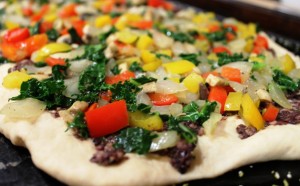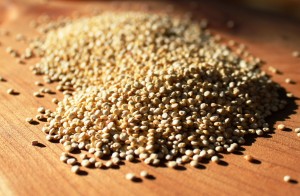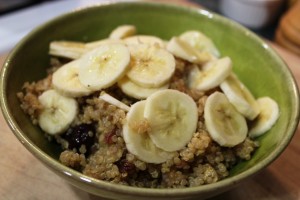
It seems like every time I go to the grocery store, there are more nondairy milk options. Just the other day, I bought a carton of sunflower seed milk! I haven’t tried it yet, so I’ll have to let you know when I do. As an adult, I’ve never been a big milk drinker. Even with the nondairy varieties, you won’t see me chugging a glassful of milk any time soon. That being said, I always keep nondairy milk in the house for baking, to pour over cereal, to add to tea/milk, and for other random uses that inevitably pop up. When I was in college and still a meat eater, I would buy unsweetened soymilk to eat with cereal (I was a bit lactose intolerant) and cow’s milk for my tea. Then, when I went vegan a few years ago and cut out cow’s milk, I had to find something else to put in my tea in the morning. I’m not crazy about the taste of soymilk in tea (unless it’s a strongly flavored tea, like a spiced chai), so I started searching for an alternative. I also was a little concerned about some of the news at the time that was starting to emerge about the long-term health effects of soy. I tried all of the different nondairy creamers and felt generally ambivalent about them. I finally settled on rice milk as the go-to milk we keep in the house. We buy the 12-pack case at Costco for around $15 and it lasts us for a few months at least. Rice milk is naturally sweet, so buying the unsweetened or at least the ‘original’ kind is preferable, and it has a very neutral flavor, so you can add it to just about anything without changing the flavor. I also keep coconut milk (in the can) and coconut milk beverage (in the carton) in the pantry and as a treat every now and then I’ll buy chocolate soymilk or almond milk (I try to buy the unsweetened and add a little sweetener myself to avoid the added sugar).
The lowdown on nondairy milks…Most of the nondairy milks are fortified with various vitamins and minerals like calcium, iron, B-12 and D, so you can check out the nutritional content to see what you’re getting. I try to buy the organic milks (particularly if I’m buying soy) to avoid any genetically modified ingredients. The flavored milks and even the original varieties are fairly high in sugar, so keep an eye on the sugar content if that’s something you’re concerned about. Also, if you buy a sweetened milk and are baking with it, you may need to cut back on the sugar used in the recipe. I try to buy the unsweetened whenever I can, as they usually tend to be quite sweet naturally. Probably one of the best things about nondairy milks is no cholesterol! You can make your own non-dairy milks, which I’ve heard can be quite easy. I have yet to try it. Have you?
Rice Milk: Rice milk is made from processed rice. The processing makes it naturally sweet, but often cane sugar or syrup is added to sweeten it more. Rice milk is a versatile milk and works well in baking and other uses. It has a thin consistency (like a skim cow’s milk) and is slightly translucent, but has a higher carbohydrate content and lower protein content than cow’s milk. I usually buy ‘Rice Dream’.
Soy Milk: Soymilk is made from soaking dried soybeans and then grinding them with water. Tofu is made by further fermenting/coagulating soymilk. Soymilk has a protein content similar to that of cow’s milk and usually has a thicker consistency than rice milk, and a more distinct flavor. I try to avoid buying nonorganic soymilk in order to avoid genetically modified (GM) soy.
Almond Milk: Almond milk can be made by combining almonds and water in the blender and then pressing through some cheesecloth. It is high in protein, is usually a thicker consistency, and is good for baking. The chocolate almond milk is delicious. The flavor of plain almond milks vary widely by brand, so you just have to try them to figure out which one you like the best. I tend to like the flavor of the Blue Diamond, though it is not organic.

Coconut Milk (in the can): Coconut milk in the can is super creamy and tastes like coconut. It is excellent for curries, for homemade vegan coconut ice cream, for rice pudding, for making chocolate truffles (yum) and all kinds of other things where you would want a very rich, creamy milk and hint of coconut flavor. It stands in well for recipes that would use half-and-half (keeping in mind the coconut flavor). You can get light coconut milk that contains less fat, fewer calories, and is thinner in consistency.

Coconut Milk (in the carton): This unsweetened Coconut Dream Coconut Drink is pretty awesome for some things. It is creamier than rice milk (not as thick or rich as coconut milk in the can) and it does not have much coconut flavor at all. In fact, in my opinion, it’s practically flavorless–which I happen to think is great. You can get a creamy effect without having to have the coconut flavor. I like to use it in coffee, where half-and-half or whole milk is called for in recipes, in chia pudding, etc.
Hemp Milk: Hemp milk is rich in all of the amino acids that make up proteins, and it is high in Omega 3s and 6s. I’ve only had hemp milk a couple of times, and it has a slight, well, ‘hempy’ flavor. It’s a little bit earthy and fiber-y tasting. I’ve had some outrageous hemp milk soft serve ice cream at Healeo on Capitol Hill in Seattle (if you haven’t been, run there and get some divinely healthy and delicious food, finished off with a vanilla hemp softserve–to die for!)
For baking, any of the nondairy milks will do. I try to match most closely what a non-vegan recipe would call for. For pancakes, I use rice milk. For pudding, I would use coconut milk (either in the can or in the carton, depending on how rich and coconutty I wanted it). For drinking in tea or coffee, you just have to test them out to see what your tastebuds like! Do you have a favorite go-to nondairy milk or two?
 Follow
Follow













